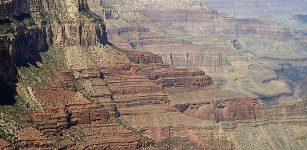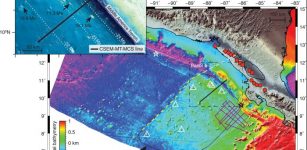Sunken Worlds Under The Pacific? Current Understanding Of Plate Tectonics – Questioned
Eddie Gonzales Jr. – MessageToEagle.com – Geophysicists at ETH Zurich have made visible areas in the Earth’s lower mantle where earthquake waves behave differently than previously thought.
Using a new model, researchers are uncovering zones in the lower mantle of the Earth where earthquake waves move slower (red) or faster (blue). The large blue zone in the western Pacific (right above the center of the image) was previously unknown. (Graphic: Sebastian Noe / ETH Zurich)
This indicates rock zones that are colder or have a different composition than the surrounding rock.
This finding calls into question the current understanding of plate tectonics.
No one can look into the Earth’s interior. Nor can anyone drill deep enough to take rock samples from the mantle between the lithosphere and the Earth’s core or to measure temperature and pressure there. That’s why geophysicists use indirect methods to see what’s going on deep beneath our feet.
For example, they use seismograms, i.e. earthquake recordings, to determine the speed at which earthquake waves propagate. This allows them to calculate the internal structure of the earth. It’s almost like doctors who use ultrasound to image organs, muscles or veins inside the body without opening the body.
Seismic waves provide information
And this is how it works: When the earth quakes, seismic waves spread out from the source in all directions. On their way through the earth, they are refracted, bent or reflected.
The speed at which the waves propagate depends on the type of wave, but also on the density and elasticity of the material through which the waves pass. Seismographic stations record these different waves, and geophysicists can use these recordings to draw conclusions about the structure and composition of the earth and to study the processes in the earth’s interior.
Earth scientists used seismic recordings to determine the location of submerged tectonic plates throughout the Earth’s mantle. They always found them where they expected: in the area of ??so-called subduction zones, i.e. where two plates meet and one sinks beneath the other into the Earth’s interior. This helped scientists to research the plate tectonic cycle, i.e. the formation and destruction of plates on the Earth’s surface over the course of Earth’s history.
Plate remains where there can be none
But now a team of geophysicists from ETH Zurich and the California Institute of Technology has made a surprising discovery: Using a new high-resolution model, they have found further areas in the Earth’s interior that look like the remains of submerged plates. However, these are not where they were expected, but also under large oceans or in the interior of continents – far away from plate boundaries. But there is no geological evidence of long-past subduction there.
What is new about their model approach is that the ETH researchers are not using just one type of earthquake wave to study the structure of the Earth’s interior, but all of them. Experts call the process full waveform inversion. This makes the model very computationally intensive, which is why the researchers used the Piz Daint supercomputer at the CSCS in Lugano. Is there a past world beneath the Pacific?
“Apparently, such zones are much more widespread in the Earth’s mantle than previously thought,” says Thomas Schouten, lead author and doctoral student at the Geological Institute of ETH Zurich.
One of the newly discovered zones lies under the western Pacific. However, according to current plate tectonic theories and findings, there should be no material from subducted plates there, because it is impossible that there were subduction zones nearby in recent geological history. However, the researchers do not know what material this is, nor what this means for the dynamics inside the Earth. “That is our dilemma. With the new high-resolution model, we can see such anomalies everywhere in the Earth’s mantle. But we do not know exactly what they are and what kind of material creates the patterns we have discovered.”
It’s like a doctor who has been using ultrasound to examine the bloodstream for decades and finds arteries exactly where he thinks they are, says ETH professor Andreas Fichtner. “However, if you give him a new, better examination instrument, he suddenly sees an artery in the buttock that doesn’t actually belong there. That’s exactly how we feel with the new findings,” explains the wave physicist. He developed the model in his group and wrote the code.
Extracting more information from the waves
So far, researchers can only speculate. “We think that the anomalies in the lower mantle have a variety of origins,” says Schouten. He thinks it’s possible that they are not just made up of cold plate material that has submerged over the last 200 million years. “It could either be very old silicate-rich material that has been there since the formation of the mantle four billion years ago and has survived despite the convection movements in the mantle. Or it could be zones where iron-rich rock has accumulated over billions of years as a result of these mantle movements,” he says.
For the earth scientist, this means above all that more research with even better models is needed to see more details in the Earth’s interior.
“The waves that we use for the model essentially only represent one property, namely the speed at which they race through the Earth’s interior,” says Schouten. However, this does not do justice to the complex interior of the Earth.
“We have to calculate the different material parameters that could produce the observed wave speeds of the different wave types. Essentially, we have to look closely at the material properties that lie behind the wave speed,” emphasises Schouten.
Written by Eddie Gonzales Jr. – MessageToEagle.com Staff Writer











